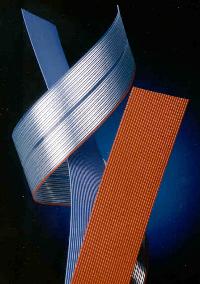 Photo ©1998 AMP INC.
Photo ©1998 AMP INC.The basic purpose of a connector is to establish a separable connection and to allow a signal to pass from point 'A' to point 'B' without unacceptable distortion or loss. The design of a connector is not simple nor is it "magic". It is a sophisticated material system in which the environments of the application are strongly interactive and complex.
The key application environments that result in such interaction are:
- Temperature
- Humidity Harsh Environment
- Durability (Wear)
- Mechanical Disturbance
The essential functional element of a connector is the contact system and is composed of three design-related elements.
Dimensional Configuration: This establishes contact forces, current carrying capacity, mechanical features, all of which are strongly influenced by space and density requirements.
Base Metal: This establishes contact spring rates. It is the basic element through which a signal passes in DC circuits and establishes the bulk resistance of a contact system. All base metals (unprotected) will form electrically disruptive films and oxides that degrade electrical performance.
Contact Finish (Plating): The contact finish protects the base metal. It extensively imparts special properties such as corrosion resistance, signal carrying capacity at high frequency, etc.
